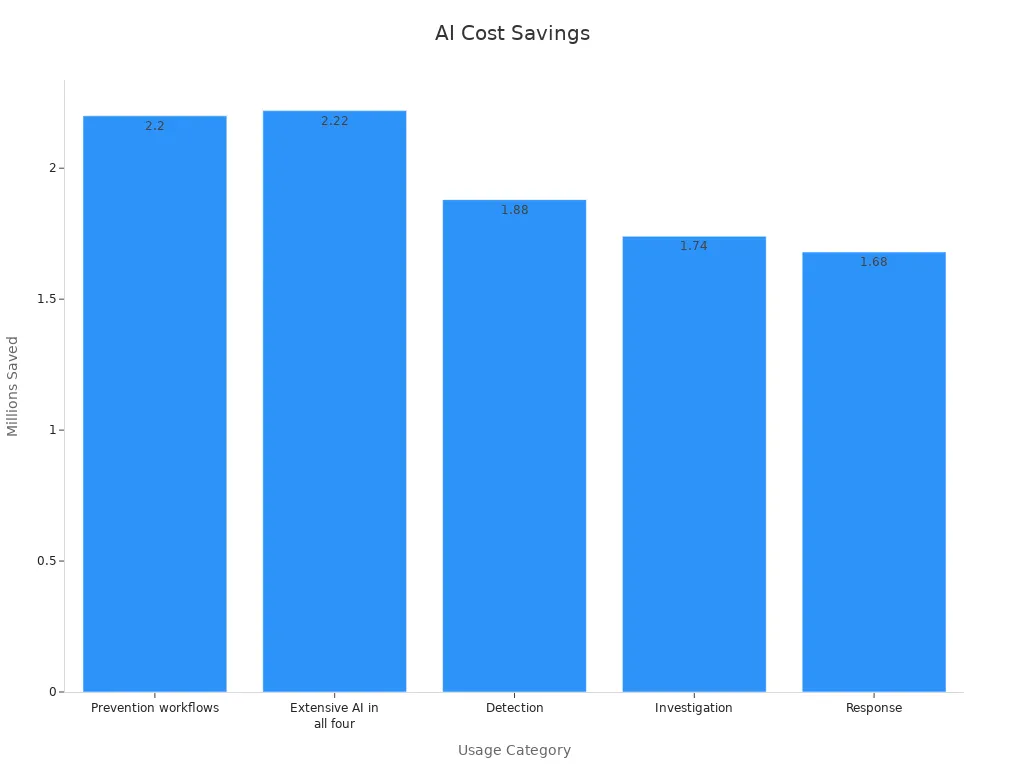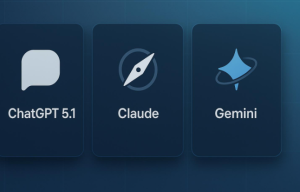
Generative ai reshapes daily life and business operations at an unprecedented pace. Leaders see rapid growth in adoption, with 97% feeling pressure to deploy ai solutions now. The following table highlights major trends and forecasts driving this urgency:
|
Metric / Trend Description |
Numerical Value / Forecast |
|---|---|
|
Generative AI market CAGR (2024-2030) |
|
|
Productivity increase from ChatGPT on text-related tasks |
Up to 40% |
|
Businesses using generative AI for synthetic customer data |
75% by 2026 (up from <5% in 2023) |
Agentic ai, custom GPTs, multimodal systems, and next-gen technology fuel this transformation. Hyper-personalization, ethical practices, and regulatory shifts shape the future of ai, making adaptation essential for everyone.
Key Takeaways
-
Generative AI is growing fast and reshaping work, business, and daily life with advanced reasoning, agentic AI, and custom GPTs.
-
Multimodal AI combines different data types like text, images, and audio to create smarter systems used in healthcare, automotive, and marketing.
-
Hyper-personalization powered by AI improves customer experience by delivering tailored recommendations and boosting engagement.
-
AI helps organizations unlock value from unstructured data and optimize supply chains, leading to cost savings and faster delivery.
-
Ethical AI practices, data security, and human oversight build trust and ensure responsible AI use amid evolving regulations.
Generative AI Trends
Advanced Reasoning
Advanced reasoning stands at the forefront of generative ai advancements in 2025. Large language models now demonstrate average human-level reasoning, as shown by recent tests from OpenAI, Google, and DeepSeek. These models use new methods like Chain of Continuous Thought and the Recurrent Depth Approach. These techniques allow models to think in continuous space, not just in words or tokens. This shift enables more flexible and efficient problem-solving.
OpenAI's models lead in performance, but others follow closely. For example, Coconut outperforms traditional methods by over 25% on planning tasks. The Recurrent Depth model matches larger models by increasing the number of reasoning steps, showing that more computation can boost intelligence without making models bigger.
Morgan Stanley reports that the demand for advanced reasoning drives investment in custom hardware. Companies now build data centers and edge solutions tailored for ai workloads. This focus on specialized technology supports the growing need for smarter, more capable models.
In daily life, these advancements mean that ai can help with complex tasks. Students use ai to solve math problems step by step. Professionals rely on ai for research, planning, and decision-making. The technology adapts to each user's needs, making it a valuable tool at work and at home.
Agentic AI
Agentic ai represents a major leap in how ai systems operate. Instead of acting as simple tools, these agents can perceive, reason, act, observe, and learn. Capital One's Chat Concierge uses four interlocking agents: one gathers information, another plans, a third checks the plan, and the last explains it to the customer. This system shows how agentic ai can handle complex customer interactions with autonomy.
|
Evidence Category |
Numerical Evidence / Metric |
Explanation / Relevance to Query |
|---|---|---|
|
Multi-agent system example |
4 interlocking agents in Capital One's Chat Concierge |
Demonstrates agentic AI with modular, autonomous components collaborating for robust customer interaction. |
|
Enterprise AI adoption in support |
35% of enterprise AI projects focused on customer support |
Shows widespread deployment of AI agents handling real-world tasks, validating agentic AI maturity. |
|
Advanced model architectures |
Mistral Mixtral 8x22B: 141B parameters (39B active at inference) |
Indicates large-scale, efficient models enabling advanced reasoning and custom GPT capabilities. |
|
Customer support AI use cases |
35% issue resolution, 14% information retrieval |
Highlights AI's practical impact in customer service, a key domain for agentic AI and reasoning applications. |
Industry experts expect agentic ai to automate knowledge work across finance, supply chain, sales, marketing, and tax. Frameworks like OpenAI's Operator and Amazon's Bedrock Agents make it easier for businesses to integrate these systems. Hospitals, retailers, and manufacturers lead in adoption, with 90% of hospitals and 76% of retailers using ai agents by 2025. In marketing, 88% of professionals use ai agents daily, speeding up content creation and decision-making.
Agentic ai saves time, with an average of 66.8% time savings compared to manual work. However, some tasks, like legal or financial advice, face higher refusal rates due to ethical and regulatory limits. Users report high satisfaction for information tasks, but lower scores for creative tasks, showing both the strengths and current limits of this technology.
Custom GPTs
Custom GPTs allow organizations to tailor large language models for specific needs. Businesses use these models to automate content creation, personalize customer experiences, and streamline operations. The impact is clear across sectors:
|
Business Environment |
Company / Sector |
GPT Implementation Focus |
Quantified Impact |
|---|---|---|---|
|
Marketing Agency |
DigitalTrendz (NY) |
Content creation automation |
50% increase in content output; 35% increase in client satisfaction |
|
E-commerce Platform |
ShopMax (London) |
Personalized shopping assistants |
60% increase in customer engagement; 25% increase in sales |
|
Educational Platform |
EduFuture (Online) |
Personalized learning content |
45% increase in course completion rates; significant student performance improvements |
|
Tech Startup |
InnovateAI (San Francisco) |
Project management automation and data analysis |
40% reduction in project delivery time; 30% decrease in operational costs |
|
Retail Company |
N/A |
Automated AI-driven customer service |
30% reduction in customer service costs |
|
Content Creation Agency |
N/A |
Faster, higher-quality content production |
25% increase in revenue |
Custom GPTs drive measurable results. Marketing agencies see a 50% boost in content output. E-commerce platforms report a 60% rise in customer engagement. Educational platforms improve course completion rates by 45%. These outcomes show how custom models transform both business and learning environments.
The rise of custom GPTs also supports cutting-edge uses in natural-language processing. Companies now deploy models that understand and respond to unique industry needs. This flexibility leads to better customer service, faster project delivery, and lower costs.
As generative ai continues to evolve, these trends—advanced reasoning, agentic ai, and custom GPTs—shape the future of work and daily life. Organizations that embrace these advancements gain a clear edge in efficiency, intelligence, and innovation.
Multimodal AI

Data Integration
Multimodal AI brings together many types of data to create smarter and more flexible models. These systems can process text, images, audio, and sensor data at the same time. This ability helps AI understand the world in a richer way. For example:
-
Multimodal AI combines medical images, patient history, and lab results to help doctors make better decisions.
-
Customer service teams use AI that understands both text and voice to solve problems faster.
-
Autonomous vehicles rely on data from cameras, LiDAR, and radar to drive safely.
-
Content creators use AI to blend text with generative images and generative video for more engaging media.
Specialized architectures, such as neural networks and deep learning models, support this integration. Data fusion techniques, like early fusion and late fusion, help merge different data types. These methods allow AI to perform complex tasks that single-mode systems cannot handle. Challenges remain, such as keeping data aligned and managing noise, but ongoing advancements continue to improve results.
Industry Use Cases
Many industries now use multimodal AI to solve real-world problems. Healthcare, automotive, customer service, and marketing lead the way. The market for multimodal AI solutions will reach about $8 billion in 2025 and grow to over $50 billion by 2033. Growth drivers include better deep learning, more available data, and lower costs for technology. The following table highlights key market details:
|
Aspect |
Details |
|---|---|
|
Market Size 2025 |
Approximately $8 billion |
|
Market Size 2033 |
Over $50 billion |
|
CAGR (2025-2033) |
Around 40% |
|
Key Regions |
North America, Western Europe (dominant); Asia-Pacific (rapid growth) |
|
Leading Industry Segments |
Healthcare, Automotive, Customer Service, Marketing |
|
Growth Drivers |
Advancements in deep learning, increased data availability, falling computational costs, growing demand across industries |
|
Key Players |
Google, Microsoft, OpenAI, Meta, NVIDIA, and others |
|
Applications |
Virtual assistants, medical diagnosis, autonomous driving, customer service, marketing |
Virtual assistants now use both voice and text to help users. In marketing, generative video and generative images create new ways to reach customers. Generative virtual worlds use multimodal AI to build interactive spaces for learning and entertainment. As technology advances, these models will continue to shape how people interact with virtual environments and digital content.
Hyper-Personalization
Creative Collaboration
Hyper-personalization powered by generative AI transforms how brands and customers work together. Companies like Walmart and Amazon now anticipate customer needs and tailor product suggestions, creating a more interactive shopping journey. Survey data shows that 60% of consumers expect brands to deliver personalized goods and services. Nearly half of shoppers willingly share more data for better recommendations. This shift raises the standard for creative collaboration, making each interaction unique.
-
Sephora’s “Virtual Artist” tool uses AI to analyze facial features, allowing virtual makeup try-ons and personalized product picks. This bridges online and in-store experiences.
-
Nike’s “Nike By You” platform generates custom product designs based on customer choices, turning shopping into a co-creative process.
-
Tommy Hilfiger’s AI-driven retargeting campaign analyzes real-time behavior and offers tailored incentives, leading to a 166% jump in conversion rates.
-
A telecom company combines AI with human agents to identify customers ready for upgrades, boosting conversion rates from 5% to 20% and lowering call center costs.
These examples show how hyper-personalization deepens engagement and fosters creative partnerships between brands and individuals.
Customer Experience
Generative AI delivers measurable improvements in customer experience. Personalized recommendations drive higher engagement and satisfaction. The following table highlights key impacts:
|
Metric Description |
Numerical Data |
Source/Context |
|---|---|---|
|
Amazon AI prediction engine revenue contribution |
Personalized product recommendations |
|
|
Netflix recommendation system viewer interactions |
80% of viewer interactions |
Personalized content recommendations |
|
Increase in conversion rates due to personalization |
10-15% increase |
Boston Consulting Group data |
|
Increase in customer loyalty from personalization |
1.5 times better loyalty |
Salesforce data |
AI chatbots now reach 1.5 billion users, a 40% increase since 2023. Conversational agents achieve 85% open rates and 40% click-through rates. Businesses report a 24.69% productivity boost and an 18% rise in customer satisfaction, with $3.50 returned for every $1 invested. Personalized experiences also reduce churn by 28%, as seen with Netflix saving $1 billion annually. These results confirm that hyper-personalization, driven by generative AI, sets a new standard for customer experience and business growth.
Unstructured Data
Insights and Value
Unstructured data surrounds every organization. Emails, social media posts, images, and sensor readings all hold valuable information. AI technologies now unlock these insights, transforming raw data into strategic assets.
-
TensorFlow, PyTorch, and HuggingFace Transformers help build and deploy models for natural language processing and computer vision.
-
Cloud AI services from AWS, Azure, and Google Cloud offer scalable APIs for analyzing text, images, and speech.
-
Data lakes and NoSQL databases store unstructured data efficiently, while vector databases enable semantic search.
-
ETL tools like Apache NiFi and Airbyte support data ingestion and transformation.
-
Foundation models such as GPT and Claude provide advanced summarization and multimodal analysis.
-
MLOps tools like Kubeflow and MLflow streamline deployment and monitoring.
AI-driven insights power real-world improvements. A retail chain used predictive analytics to optimize inventory, reducing waste and boosting profits. In healthcare, predictive models identified high-risk patients, improving outcomes. AI analyzes unstructured data from sources like emails and IoT sensors, leading to better efficiency, customer experience, and risk management. Gartner predicts a 25% increase in operational efficiency by 2026 for organizations using AI on unstructured data. Firms using AI-driven analytics saw an average 20% revenue growth in 2024.
AI enables faster time-to-insight, supporting strategic decisions and future-proofing businesses in a data-driven world.
Content Supply Chains
AI transforms content supply chains by automating and optimizing every step. Amazon’s AI-driven supply chain sets a benchmark for efficiency and scalability in global logistics. Companies now use AI to forecast demand, balance inventory, and automate warehouse operations.
|
Efficiency Metric / AI Application |
Description / Result |
|---|---|
|
Average Monthly Cost Savings |
5.76% cost reduction through AI-driven optimization of goods distribution and routing |
|
Delivery Time Reduction |
Up to 50% reduction in delivery time for certain clusters |
|
Inventory Management |
AI forecasts demand and reduces overstocking/understocking costs |
|
Route Optimization |
AI finds efficient routes, saving fuel and time |
|
Warehouse Automation |
Robots automate picking, packing, and sorting |
|
Risk Management |
AI simulates scenarios for better contingency planning |
|
Sustainability |
AI reduces waste, energy use, and fuel consumption |
AI-powered robots improve speed and accuracy in warehouses. Algorithms optimize delivery routes and schedules. These advances lead to lower costs, faster delivery, and more sustainable operations. Companies that integrate AI into their content supply chains gain a competitive edge and adapt quickly to market changes.
Ethical and Sustainable AI
Data Security
Organizations now place data security at the center of their ai strategies. Ethical ai practices help protect sensitive information and reduce the risk of breaches. Companies use ai to prevent, detect, investigate, and respond to threats. These actions lead to faster breach containment and lower costs. The table below shows how ai improves security outcomes:
|
AI Usage Category |
Impact on Data Breach Costs and Containment |
|---|---|
|
Prevention workflows |
Organizations using AI saved an average of USD 2.2 million in breach costs vs. no AI use. |
|
Extensive AI in all four categories (prevention, detection, investigation, response) |
Reduced breach costs by up to 45.6% (e.g., USD 3.76M vs. USD 5.98M) |
|
Detection |
Cost savings of USD 1.88 million compared to no AI use. |
|
Investigation |
Cost savings of USD 1.74 million compared to no AI use. |
|
Response |
Cost savings of USD 1.68 million compared to no AI use. |
|
Breach containment speed |
AI use accelerated breach identification and containment by nearly 100 days faster (e.g., 111 days faster in prevention). |
|
Organizational policies |
75% of organizations have AI security, ethics, and governance policies in place, indicating ethical AI strategy adoption. |

Most organizations now adopt ai security and governance policies. These steps show a strong commitment to ethical ai and responsible intelligence use. Science teams also rely on ai in science to protect research data and maintain trust.
Environmental Impact
The environmental impact of ai has become a top concern for leaders in science and technology. Training large models once required massive energy, but new methods now reduce the carbon footprint. Companies use several strategies to make ai more sustainable:
-
Model compression and fine-tuning lower energy use during training.
-
Specialized, energy-efficient hardware reduces power consumption.
-
Data centers powered by renewable energy, such as hydroelectric power, cut emissions.
-
Efficient cooling systems and optimized ai architectures decrease environmental costs.
-
Strategic placement of data centers near renewable resources minimizes impact.
-
Responsible e-waste management prevents contamination.
-
Smaller, task-specific ai models use less electricity.
These efforts show that science and industry can balance ai growth with environmental responsibility. Sustainable ai practices help protect the planet while advancing intelligence and innovation.
Regulation and Trust
Compliance
Regulatory compliance shapes how organizations develop and deploy ai in 2025. The United States does not have a single federal law for ai. Instead, states like Colorado and California lead with their own rules. Colorado’s CPIAIS law, effective in 2026, requires companies to manage risks, perform annual impact assessments, and report discrimination. California’s pending amendments to FEHA focus on automated decision systems, record retention, and anti-bias testing. Virginia considered similar rules but vetoed them due to concerns about regulatory burden.
|
Jurisdiction |
Regulation/Status |
Key Provisions |
Impact on Industry Development in 2025 |
|---|---|---|---|
|
Colorado |
CPIAIS, Passed, Effective Feb 2026 |
Applies to high-risk AI in consequential decisions (hiring, promotion, termination); duties on developers and deployers to avoid algorithmic discrimination; requires risk management programs, annual impact assessments, transparency, and reporting discrimination to Attorney General within 90 days |
Imposes compliance obligations that shape AI adoption strategies, emphasizing risk mitigation and transparency, influencing operational practices and investment decisions |
|
California |
Amendments to FEHA, Pending Approval (expected July 2025) |
Defines automated decision systems (ADS), mandates record retention for 4 years, requires notice to employees/applicants, accommodations for disabilities/religious needs, anti-bias testing relevance in legal claims |
Signals increased regulatory scrutiny on AI in employment, prompting employers to adjust AI use policies and compliance frameworks, affecting innovation and deployment timelines |
|
Virginia |
High-Risk AI Developer and Deployer Act, Vetoed |
Similar to Colorado's CPIAIS but vetoed due to regulatory burden concerns |
Demonstrates legislative challenges and industry pushback, reflecting tension between regulation and innovation incentives |
In 2025, organizations must navigate a patchwork of state laws and evolving federal guidance. This fragmented environment creates compliance challenges and shapes how businesses invest in ai. Overlapping legal areas, such as data protection and intellectual property, add complexity. Companies must adapt quickly to avoid legal and reputational risks.
Real-world failures highlight the need for strong compliance. Amazon’s ai hiring tool showed gender bias, leading to its shutdown. The COMPAS tool in criminal justice misclassified risk based on race. Deepfakes have caused misinformation and fraud. These cases show why new laws demand safety checks, audits, and documentation.
Human-in-the-Loop
Human-in-the-loop (HITL) models play a key role in building trust in ai systems. These models combine human judgment with machine intelligence. In healthcare, radiologists reviewing ai-flagged cases reduce diagnostic errors by 37%. Financial institutions see a 28% drop in approval disparities when humans review ai decisions. Social media platforms improve content moderation accuracy by 45% with human oversight.
|
Domain |
HITL Improvement Metric |
Impact on Trust and Performance |
|---|---|---|
|
Healthcare AI |
37% reduction in diagnostic errors when radiologists review low-confidence cases |
Increased physician trust and adoption rates |
|
Financial Lending |
28% reduction in approval disparities across demographic groups with HITL review |
Enhanced fairness and operational efficiency |
|
Social Media |
45% improvement in content moderation accuracy and consistency with human review |
Better handling of cultural context and policy adherence |
Human oversight ensures that ai systems remain fair, transparent, and accountable. Organizations that use HITL models gain higher trust from users and regulators. This approach supports responsible ai adoption and helps meet new compliance standards.
Generative AI Impact

Workforce
Generative AI transforms the workforce by creating new roles and changing how people work. Organizations now hire AI trainers, ethics specialists, prompt engineers, AI quality assurance analysts, data curators, AI product managers, and digital twin specialists. These jobs show a shift in talent needs and skill sets. AI trainers and ethics specialists help train systems and keep standards high. Prompt engineers design inputs for accurate outputs, while quality assurance analysts check the usefulness of AI-generated content. Data curators manage information for training, and product managers connect AI with business goals. Digital twin specialists use science to build virtual models for process improvement.
Many companies use strategic workforce planning to adapt. They reskill employees and use proactive talent strategies. Studies show that generative AI users save about 2.2 hours per week, and overall productivity rises by 1.1%. In information services, AI accounts for 14% of work hours, leading to the highest time savings. Customer support agents using AI assistants see a 14% productivity boost. Over 25% of new code at Google is now AI-generated. These changes require leaders to focus on transparency, fairness, and employee confidence.
Forward-thinking organizations treat AI as a people strategy, not just a technology upgrade.
Education
AI drives rapid change in education. The global EdTech market will reach $404 billion by 2025, more than doubling since 2019. AI-powered personalized learning improves student outcomes by up to 30%. Nearly 60% of U.S. principals use AI tools to automate tasks and engage students. Adaptive platforms like Khanmigo adjust to each learner, closing gaps faster. Tools such as speech-to-text and Immersive Reader make learning more accessible for students with disabilities.
|
Statistic / Finding |
Description |
|---|---|
|
Market Growth |
EdTech market projected at $404B by 2025, 16.3% CAGR |
|
Personalized Learning Impact |
Up to 30% improvement in student outcomes |
|
AI Adoption in Schools |
60% of U.S. principals use AI tools |
|
Adaptive Learning Platforms |
Real-time adjustment to student needs |
|
Accessibility Enhancements |
Improved access for students with disabilities |
AI also changes how schools assess and teach. New metrics measure critical thinking, inquiry skills, and AI literacy. Teacher training now includes AI and media literacy, with a focus on ethics. Schools prepare students for a future where AI is a core subject.
Public Sector
Public sector organizations use generative AI to improve services and save resources. Utah’s government uses AI to handle 2 TB of cybersecurity data daily, improving risk management. The U.S. Department of State saves tens of thousands of employee hours by using AI for drafting, translation, and brainstorming. Pennsylvania and Colorado state governments report that employees save over an hour per day with AI tools. Swindon Borough Council in the UK cut translation costs by 99.96% and reduced document processing time from 16 days to 14 minutes.
|
Public Sector Entity |
Use Case Description |
Quantified Benefit(s) |
|---|---|---|
|
Utah State Government |
Cybersecurity data handling |
Improved alert quality, proactive risk mitigation |
|
US Department of State |
Drafting, translation, policy brainstorming |
Tens of thousands of hours saved |
|
Pennsylvania State Government |
AI tools for employees |
>1 hour saved per user per day |
|
Colorado State Government |
AI tools for employees |
6+ hours saved per user per week |
|
Swindon Borough Council (UK) |
Document translation |
Costs cut by 99.96%, time cut from 16 days to 14 mins |
|
US Department of Treasury |
Fraud detection in payments |
$4B in improper payments prevented or recovered |
AI helps governments respond faster, reduce costs, and improve transparency. Leaders in the public sector must ensure ethical use, data security, and public trust as they adopt new technology.
Generative AI will shape the future of work, home, and society. Microsoft leaders note that AI’s new reasoning and autonomy will drive innovation and address global challenges. Deloitte predicts a surge in adoption, with the market doubling energy use by 2030. To prepare, organizations should focus on skills, cross-functional teams, and clear objectives:
|
Action Area |
Benefit |
|---|---|
|
Skills development |
Close knowledge gaps |
|
Experimentation |
Foster safe AI adoption |
|
Data governance |
Boost project success |
|
Incremental implementation |
Higher satisfaction and ROI |
Staying proactive ensures everyone benefits from these trends as AI becomes central to daily life and the future.








